Description
Many organizations occasionally encounter employees who:
- Frequently complain or gossip
- Use unprofessional or inappropriate language
- Display minor acts of insubordination
But Toxic Employees have interpersonal styles that demonstrate a pattern of counter-productive work behaviors. While Emotionally Intelligent employees being aware of their feelings & those of others exhibit a pattern of appropriate self–management.
The issue of toxic employees is more widespread than many realize. Research reveals that:
- 95% of employees have encountered a toxic coworker, and 64% are currently working with one
- 50% have considered quitting, and 12% actually left their job because of a toxic colleague
- 25% have intentionally reduced their work effort due to a toxic team member
- 20% feel targeted by toxic behavior on a weekly basis, and 10% witness such behavior daily
Toxic employees cause significant overt, covert, people-related & financial damage with their visible behavior just being the tip of the iceberg. For example, in one organization the day a former employee left the organization is considered one of their annual holidays.
Why should you attend ?
Clever toxic employees often:
- Leverage their technical skills to intimidate or manipulate others
- Know exactly who to charm and who they can mistreat
- Adjust their behavior to create a favorable impression when it suits them
Unfortunately, organizations can unintentionally enable or even reinforce toxic behavior by:
- Restructuring roles to accommodate a toxic individual
- Overlooking toxic behavior in employees who possess valuable skills
- Failing to proactively seek employee input on workplace toxicity
- Not clearly defining unacceptable interpersonal behavior or outlining the consequences for such actions
Managers may try to address toxicity by focusing on an employee’s attitude. While attitude plays a role in behavior, attempting to change someone’s mindset is often ineffective and unrealistic. A more effective approach for managers is to:
- Address the specific behaviors that are harming team morale or organizational performance
- Apply consistent positive and negative consequences to shape those behaviors
Session Highlights:
I. Human and Financial Impact of Toxic Employees
Toxic employees contribute to:
- Disruption and needless complexity
- Visible harm to people or processes
- Hidden or indirect damage
- Conflict, stress, and emotional strain
- Declines in productivity, work quality, and overall financial performance
II. The A, B, C’s Related to Toxic Employees
- Employee attitudes
- Employee behaviors
- Consequences that managers can exert
III. Understanding the Mindset of a Toxic Employee
Common Toxic Behaviors Include:
-
Exploiting their reputation or technical skills to manipulate and intimidate
-
Acting like a social chameleon—knowing exactly who to impress and who they can mistreat
-
Switching their toxic behavior on and off based on the image they want to project
-
Toxic behavior typically appears in three key forms
IV. Common Responses to Toxic Employees That Often Prove Ineffective
- Adjusting the toxic employee’s role to fit their behavior
- Allowing toxic employees to continue due to their unique skills or experience
- Failing to actively gather employee feedback about toxic behavior in the workplace
- Not clearly communicating to all staff which behaviors are unacceptable and the consequences that follow
V. Effective Strategies for Addressing and Preventing Toxicity
Organization-Wide Approaches:
- Embedding positive interpersonal behavior as a core organizational value
- Including interpersonal skills in performance evaluations
- Training leaders to recognize and address toxic behavior
- Incorporating behavior-based questions during hiring to screen out potentially toxic candidates
- Conducting exit interviews to uncover any toxic workplace issues
Departmental and Team Approaches:
- Clearly defining acceptable interpersonal behaviors with specific examples and standards
- Using team discussions and role-playing exercises to reinforce these behavioral expectations
- Implementing 360-degree feedback to gauge the workplace environment
Individual Approaches:
- Clearly communicating which behaviors are unacceptable and explaining why
- Describing both inappropriate and appropriate behaviors explicitly
- Requesting the employee’s commitment to change and their plan for doing so
- Providing frequent, focused coaching and feedback
- Engaging executive coaches when needed
- Applying progressive disciplinary measures
- Proceeding with termination if necessary
But even terminations are not a cure-all because the:
- Toxic-enabling people & organizational culture tendencies may remain
- Employees may still be resentful of the way they were treated by the employee & the time it took the organization to react
- Expertise & experience of the toxic employee are lost
Who should attend ?
Anyone with managerial or leadership responsibility







